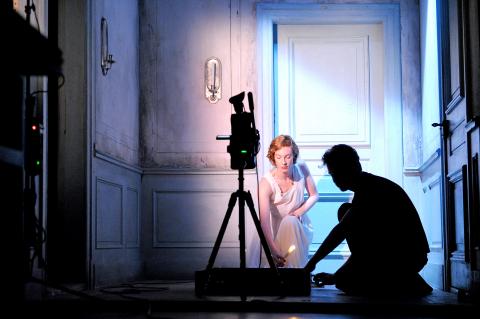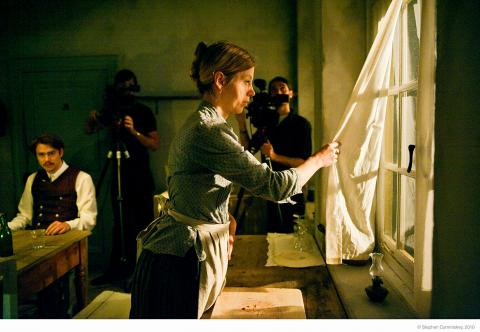Swedish author and playwright August Strindberg’s groundbreaking look at class differences, sexual politics and theater staging, Miss Julie, has been dissected, analyzed, criticized and reworked in various genres since it was written in 1888.— as has he.
For generations, stage and film directors around the world have given their takes on his story of an aristocrat, Miss Julie, and her encounters with her father’s manservant, Jean, after an alcohol-fueled Midsummer Eve’s party and the repercussions for all involved.
British theater and opera director Katie Mitchell gained fame for her multi-media works and for telling stories from a female perspective, and her 2010 production of Miss Julie for Berlin’s Schaubuhne theater was no exception.

Photo courtesy of Thomas Aurin
Her production will be performed at the National Theater in Taipei this weekend, for three shows starting tomorrow night.
Alhough Mitchell has worked primarily in Europe in recent years, Miss Julie was her first in Berlin and her first for the Schaubuhne, which was founded in 1962.
Thomas Ostermeier, who took over as Schaubuhne’s artistic director in 1999, turned it into a repertory-style theater with a permanent ensemble of actors. The cast that will be performing at the National Theater is largely the original one, with Jule Bowe reprising her role as Kristin, with Tilman Strauss as Jean and Luise Wolfram and Miss Julie.

Photo courtesy of Stephen Cummiskey
The big difference with Mitchell’s take on Strindberg’s play is that she utilized a film crew on stage to capture the action, and shifted the focus of the story to the perspective of what was traditionally one of the minor characters, the family cook Christine (Kristin in this production), who is Jean’s fiance and a witness, albeit sometimes a sleeping one, to Julie and Jean’s pursuit of one another.
Mitchell tapped Leo Warner, cofounder of the Britain-based Fifty Nine Productions and a frequent collaborator, to work with her on the live video side of the production and they share director credits for the show.
Mitchell and Warner have been credited with pioneering a new medium — “live cinema” and that concept seems well-suited for Miss Julie because Strindberg’s play was conceived as a new medium, a call to revolution of the standard Swedish theater conventions of his day. He wanted to see theater that was as natural as possible, free from all artifice, because he fell that this would lead to a greater understanding of humanity.
By using a black-clad film crew to provide video footage of the stage action, the audience is provided with a much closer look at the character’s actions and interactions as they occur on stage.
There are a couple of caveats that come along with this Miss Julie production. One is that it is not suitable for those under the age of 12, which one would think would be self-evident. The others are that there is partial nudity, and that latecomers might not be admitted.
The play runs 75 minutes and will be performed in German with Chinese and English surtitles.
There will be a post-show discussion in the theater lobby after Sunday’s matinee.

May 26 to June 1 When the Qing Dynasty first took control over many parts of Taiwan in 1684, it roughly continued the Kingdom of Tungning’s administrative borders (see below), setting up one prefecture and three counties. The actual area of control covered today’s Chiayi, Tainan and Kaohsiung. The administrative center was in Taiwan Prefecture, in today’s Tainan. But as Han settlement expanded and due to rebellions and other international incidents, the administrative units became more complex. By the time Taiwan became a province of the Qing in 1887, there were three prefectures, eleven counties, three subprefectures and one directly-administered prefecture, with

It’s an enormous dome of colorful glass, something between the Sistine Chapel and a Marc Chagall fresco. And yet, it’s just a subway station. Formosa Boulevard is the heart of Kaohsiung’s mass transit system. In metro terms, it’s modest: the only transfer station in a network with just two lines. But it’s a landmark nonetheless: a civic space that serves as much more than a point of transit. On a hot Sunday, the corridors and vast halls are filled with a market selling everything from second-hand clothes to toys and house decorations. It’s just one of the many events the station hosts,

Two moves show Taichung Mayor Lu Shiow-yen (盧秀燕) is gunning for Chinese Nationalist Party (KMT) party chair and the 2028 presidential election. Technically, these are not yet “officially” official, but by the rules of Taiwan politics, she is now on the dance floor. Earlier this month Lu confirmed in an interview in Japan’s Nikkei that she was considering running for KMT chair. This is not new news, but according to reports from her camp she previously was still considering the case for and against running. By choosing a respected, international news outlet, she declared it to the world. While the outside world

Through art and storytelling, La Benida Hui empowers children to become environmental heroes, using everything from SpongeBob to microorganisms to reimagine their relationship with nature. “I tell the students that they have superpowers. It needs to be emphasized that their choices can make a difference,” says Hui, an environmental artist and education specialist. For her second year as Badou Elementary’s artist in residence, Hui leads creative lessons on environmental protection, where students reflect on their relationship with nature and transform beach waste into artworks. Standing in lush green hills overlooking the ocean with land extending into the intertidal zone, the school in Keelung